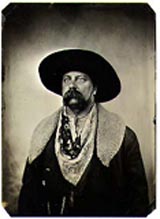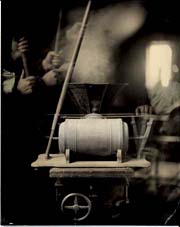| Photography
Photography used to be a little more difficult than it is today. (Justin and Robby—are you listening?) They used wet plates. I never knew, in detail, what this was. Well—it seems to be making a comeback.
I could never understand the fascination of Civil War re-enactments. It seems just so bizarre. But, thanks to these re-enactments, there seems to be photographers using these early photographic techniques. Which is just to cool.
The Civil War gave a big boost to photography. It was the first war that came to Americans via photographs.
Civil War Photography Center
The photography of the Civil War is perhaps the single most important element that stimulates our interest in the conflict. Yet no aspect of the war is so routinely taken for granted. Most Civil War books that feature original war photographs use them exclusively as illustrations and ignore the underlying story of how and why the images were made.
Photography in the United States was 21 years old when the Civil War started and, literally, had come of age. The craft had undergone dramatic changes since the mirror image of the daguerreotype-the first commercial form of photography--was introduced in the United States in 1839. Even more progress was made during the war.
[read more]
----------
"Wet Plate" Collodion Photography
In efforts to advance photography in the mid-19th century, Fredrick Scott Archer, an English sculptor and photographer, experimented with collodion in the hope of producing a photographic negative on ordinary glass plates.
Collodion, a thick and syrupy liquid, is made by dissolving nitrated cotton in a mixture of alcohol and ether. It was widely used by surgeons as a liquid bandage owing to its strength and adhesion.
In 1851, Archer used collodion to hold light-sensitive salts to his glass plates. Once the salts, such as potassium iodide, were in the mixture of collodion, the viscous liquid was poured onto the plate. Allowing the alcohol and ether to evaporate, a thin film containing the necessary iodides was left on the plate. Ready for sensitizing, the plate was placed in a bath of silver nitrate. This formed a light sensitive compound of silver iodide on the surface of the plate.
Once sensitized, the plate was exposed in the camera before the collodion began to set and dry. If the plate dried before development,it i would have had practically no sensitivity and would be therefore useless. For this reason alone, the process Archer invented became known as "Wet Plate" collodion process.

Brad Bingham. 1/2 plate ferrotype. 1997.
[read more]
----------
More collodian artists: George Berkhoffer, Collodian Photographer, The Photography of Wayne L. Pierce, and Civil War Photography.
---------
Not all collodian artists are stuck in the 19th Century.
Scully & Osterman

[read more]
all the collodian links are thanks to James Luckett atconsumptive.org
----------
Scully & Osterman are involved with a bit of photographic history.
The Lincoln Project

Detail of Abraham Lincoln salt print. Image size is 11" x 14."
The original negative was made by Alexander Gardner Nov. 8, 1863, 11 days before Lincoln's Gettysburg address.
The interpositive and new 11" x14" negative were made by Mark Osterman using the collodion process. This procedure is rarely done today requiring a master collodion photographer to achieve these amazing results.
The salt prints are made by France Scully Osterman. Each print is made on Strathmore 500 series plate finish paper; hand-coated first with salt and then silver solutions. The coated paper is placed with the negative in a printing frame and exposed to light. The print is washed and fixed, washed again, and heat-toned. Each print is then retouched and hand-waxed with bees wax and oil of lavender.
Edition is limited to 375 prints, $3750 each.
[read more] |

